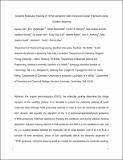| dc.contributor.author | Giri, Guarav | |
| dc.contributor.author | Verploegen, Eric | |
| dc.contributor.author | Mannsfeld, Stefan C. B. | |
| dc.contributor.author | Atahan, Sule | |
| dc.contributor.author | Kim, Do Hwam | |
| dc.contributor.author | Lee, Sang Yoon | |
| dc.contributor.author | Beccerril, Hector A. | |
| dc.contributor.author | Aspuru-Guzik, Alan | |
| dc.contributor.author | Toney, Michael F. | |
| dc.contributor.author | Bao, Zhenan | |
| dc.date.accessioned | 2012-03-14T14:09:40Z | |
| dc.date.issued | 2011 | |
| dc.identifier.citation | Giri, Gaurav, Eric Verploegen, Stefan C. B. Mannsfeld, Sule Atahan-Evrenk, Do Hwan Kim, Sang Yoon Lee, Hector A. Becerril, Alán Aspuru-Guzik, Michael F. Toney, and Zhenan Bao. 2011. Tuning charge transport in solution-sheared organic semiconductors using lattice strain. Nature 480(7378): 504–508. | en_US |
| dc.identifier.issn | 0028-0836 | en_US |
| dc.identifier.issn | 1476-4687 | en_US |
| dc.identifier.uri | http://nrs.harvard.edu/urn-3:HUL.InstRepos:8365120 | |
| dc.description.abstract | Circuits based on organic semiconductors are being actively explored for flexible, transparent and low-cost electronic applications. But to realize such applications, the charge carrier mobilities of solution-processed organic semiconductors must be improved. For inorganic semiconductors, a general method of increasing charge carrier mobility is to introduce strain within the crystal lattice. Here we describe a solution-processing technique for organic semiconductors in which lattice strain is used to increase charge carrier mobilities by introducing greater electron orbital overlap between the component molecules. For organic semiconductors, the spacing between cofacially stacked, conjugated backbones (the π–π stacking distance) greatly influences electron orbital overlap and therefore mobility. Using our method to incrementally introduce lattice strain, we alter the π–π stacking distance of 6,13-bis(triisopropylsilylethynyl) pentacene (TIPS-pentacene) from 3.33Å to 3.08 Å. We believe that 3.08Å is the shortest π–π stacking distance that has been achieved in an organic semiconductor crystal lattice (although a π–π distance of 3.04Å has been achieved through intramolecular bonding). The positive charge carrier (hole) mobility in TIPS-pentacene transistors increased from \(0.8 cm^2 V^{−1} s^{−1}\) for unstrained films to a high mobility of \(4.6 cm^2 V^{−1} s^{−1}\) for a strained film. Using solution processing to modify molecular packing through lattice strain should aid the development of high-performance, low-cost organic semiconducting devices. | en_US |
| dc.description.sponsorship | Chemistry and Chemical Biology | en_US |
| dc.language.iso | en_US | en_US |
| dc.publisher | Nature Publishing Group | en_US |
| dc.relation.isversionof | doi:10.1038/nature10683 | en_US |
| dash.license | OAP | |
| dc.title | Tuning Charge Transport in Solution-Sheared Organic Semiconductors Using Lattice Strain | en_US |
| dc.type | Journal Article | en_US |
| dc.description.version | Accepted Manuscript | en_US |
| dc.relation.journal | Nature | en_US |
| dash.depositing.author | Aspuru-Guzik, Alan | |
| dc.date.available | 2012-03-14T14:09:40Z | |
| dc.identifier.doi | 10.1038/nature10683 | * |
| dash.authorsordered | false | |
| dash.contributor.affiliated | Atahan, Sule | |
| dash.contributor.affiliated | Aspuru-Guzik, Alan | |


